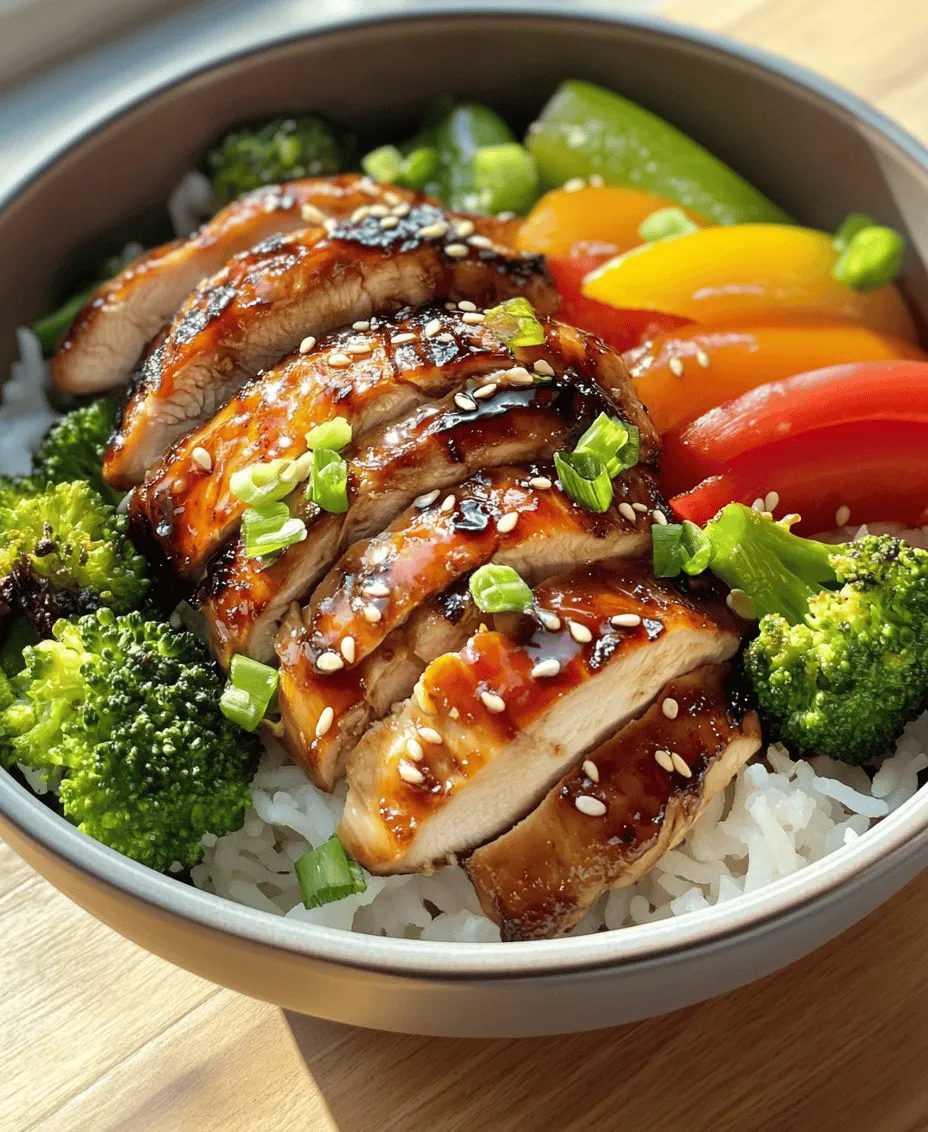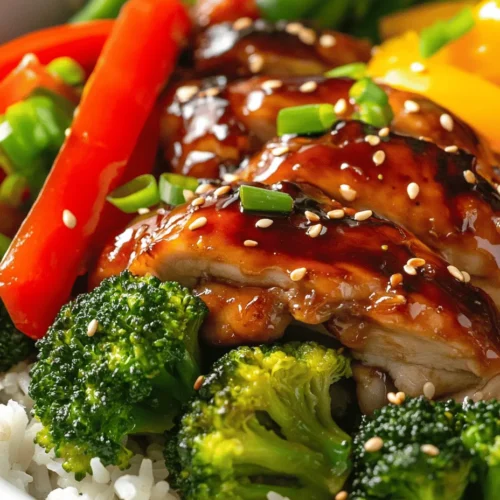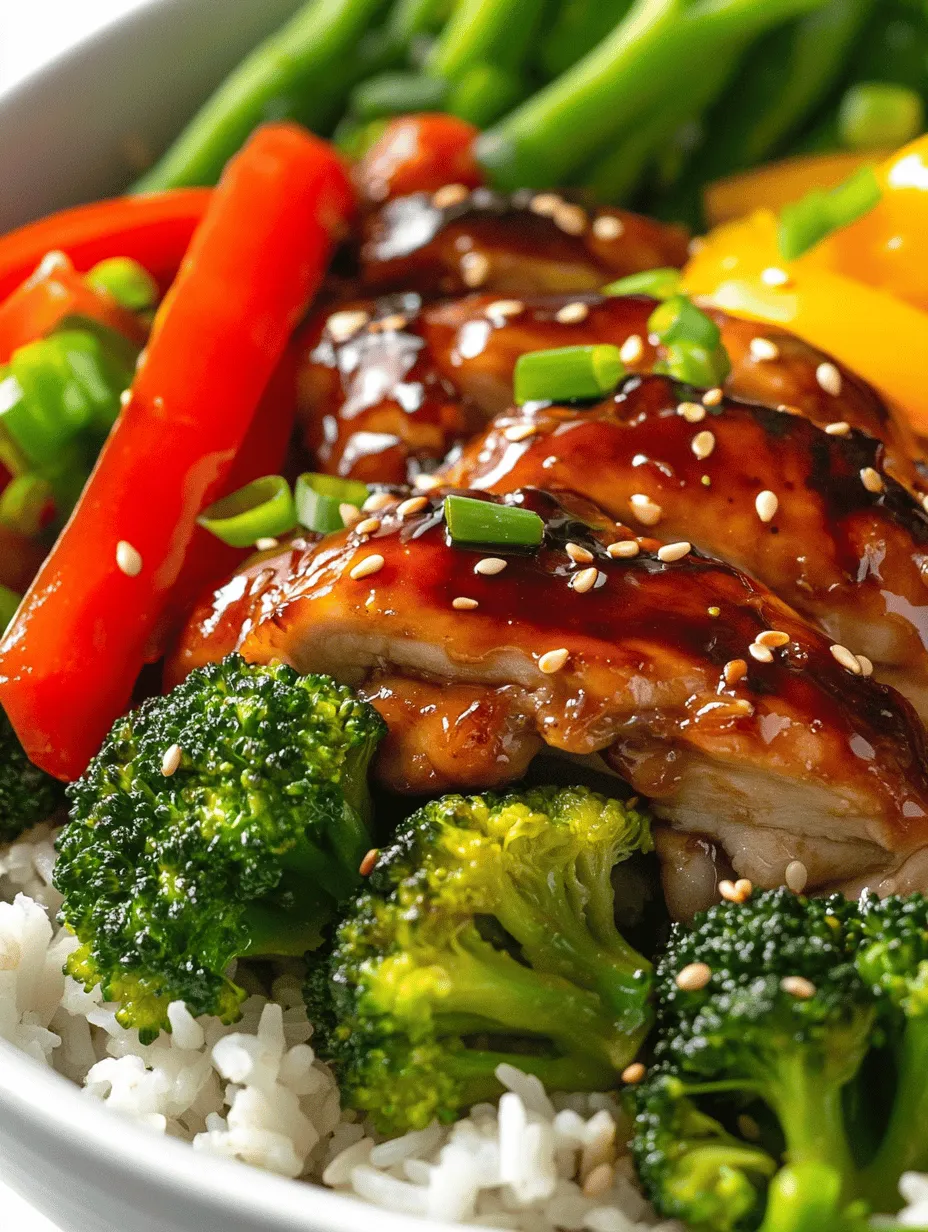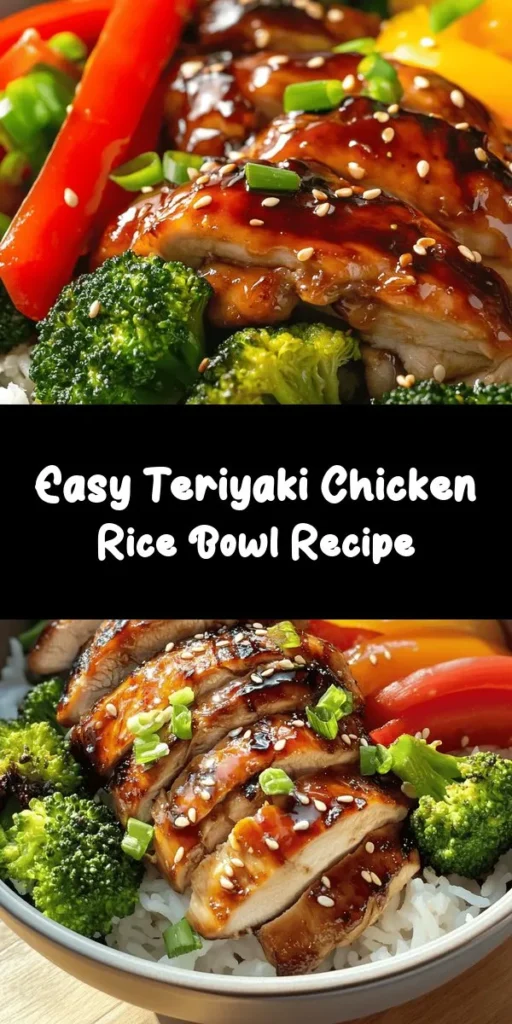Introduction
The Teriyaki Chicken Rice Bowl has become a beloved staple in Asian cuisine, celebrated for its harmonious blend of flavors and textures. Originating from Japan, this dish combines succulent marinated chicken, vibrant vegetables, and fluffy rice, creating a meal that is both satisfying and nutritious. In today’s fast-paced world, the importance of preparing homemade meals cannot be overstated. Not only do they allow you to control the ingredients and flavors, but they also promote a healthier lifestyle by minimizing processed foods.
The Teriyaki Chicken Rice Bowl exemplifies this balance, featuring lean protein from the chicken, a colorful array of vegetables, and carbohydrates from the rice. This dish is not just a treat for the palate; it is a wholesome meal that can be enjoyed by the whole family. Whether you are looking for a quick weeknight dinner or a dish to impress guests, this recipe fits the bill perfectly.
Understanding Teriyaki Cuisine
Definition and Origins of Teriyaki Cooking Style
Teriyaki, derived from the Japanese words “teri,” meaning glaze, and “yaki,” meaning grill or broil, refers to a cooking technique where food is grilled or broiled with a glaze made from soy sauce, mirin, and sugar. This method not only enhances the flavor of the ingredients but also gives them a beautiful, shiny finish. While the term “teriyaki” is often used in Western cuisine to describe a variety of dishes, its roots lie firmly in Japanese culinary traditions.
The origins of teriyaki can be traced back to the 17th century, when it was first popularized in Japan. Originally, it was a simple dish made with fish, which was grilled and brushed with a soy-based sauce. Over time, the technique evolved to include various proteins, with chicken emerging as a popular choice, particularly in the post-World War II era when American soldiers returned home with a newfound love for Japanese food.
Key Ingredients Commonly Found in Teriyaki Dishes
The magic of teriyaki lies in its simple yet impactful ingredients that work together to create a rich and savory flavor profile. The primary components of teriyaki sauce include soy sauce, mirin, and sugar, each contributing distinct qualities to the dish.
– Soy Sauce: The backbone of any teriyaki sauce, soy sauce provides umami—a taste often described as savory or meaty. It comes in various types, including light, dark, and low-sodium, allowing cooks to choose based on their flavor preference and dietary needs.
– Mirin: This sweet rice wine adds depth and complexity to the sauce. It has a mild sweetness that balances the saltiness of the soy sauce, making it an essential component of traditional teriyaki.
– Sugar: Typically brown sugar is used to enhance the sweetness of the teriyaki sauce. It not only adds flavor but also aids in caramelization when the chicken is cooked.
– Sesame Oil: A staple in Asian cooking, sesame oil contributes a nutty flavor that complements the other ingredients in the dish.
– Garlic and Ginger: These aromatic ingredients bring a fragrant essence to the teriyaki chicken, elevating the overall taste.
The Cultural Significance of Teriyaki Chicken in Japanese Cuisine
Teriyaki chicken holds a special place in Japanese cuisine, often served at family gatherings, celebrations, and even at restaurants. It embodies the Japanese philosophy of “umami,” which emphasizes balance and harmony in flavors. The dish is not only a source of nourishment but also a means of bringing people together around the dining table, reinforcing the value of shared meals in Japanese culture.
In recent years, teriyaki chicken has transcended its cultural roots and gained popularity worldwide. Its versatility has made it a favorite among many, allowing chefs and home cooks alike to experiment with different ingredients and variations, while still honoring the essence of traditional teriyaki cooking.
Ingredients Breakdown
Creating a mouthwatering Teriyaki Chicken Rice Bowl requires selecting quality ingredients. Here’s a detailed breakdown of each component, highlighting their importance and benefits.
Boneless, Skinless Chicken Thighs
For this recipe, boneless, skinless chicken thighs are the ideal choice. Unlike chicken breasts, which can dry out easily, thighs remain juicy and tender even after cooking. They have a rich flavor that pairs beautifully with the teriyaki sauce, ensuring that each bite is packed with taste. Additionally, chicken thighs are often more affordable than breasts, making them a budget-friendly option for families.
Soy Sauce
Soy sauce comes in various types, and understanding these variations can elevate your teriyaki chicken. Regular soy sauce is commonly used, but you can also opt for low-sodium soy sauce for a healthier option. Dark soy sauce adds a deeper color and richer flavor, while light soy sauce is saltier and more delicate. Choosing the right soy sauce can make a significant difference in the overall taste of your dish.
Mirin
Mirin is a sweet rice wine that plays a crucial role in flavor enhancement. Its sweetness balances the saltiness of the soy sauce, creating a well-rounded teriyaki sauce. If you can’t find mirin, you can substitute it with a mixture of sake and sugar, or even use a combination of white wine and sugar as an alternative.
Brown Sugar
Brown sugar is the traditional sweetening agent in teriyaki sauce. Its molasses content lends a rich flavor and depth to the sauce, making it more complex than white sugar. If you prefer a healthier alternative, you can use honey or maple syrup; however, be cautious with the amounts, as these can vary in sweetness.
Sesame Oil
Sesame oil is a key ingredient in Asian cooking, known for its distinct nutty flavor. It adds a unique depth to the teriyaki sauce and enhances the overall flavor of the dish. A little goes a long way, so use it sparingly to avoid overpowering the other ingredients.
Garlic and Ginger
Garlic and ginger are aromatic staples in many Asian dishes, providing not only flavor but also numerous health benefits. Garlic is known for its immune-boosting properties, while ginger aids in digestion and has anti-inflammatory effects. Together, they create a fragrant base for the teriyaki sauce and complement the chicken beautifully.
Vegetables (Broccoli and Bell Peppers)
Incorporating vegetables into your teriyaki chicken rice bowl not only adds nutritional value but also enhances the visual appeal. Broccoli is rich in vitamins C and K, while bell peppers provide a vibrant pop of color and are high in antioxidants. By adding these vegetables, you create a balanced meal that is both healthy and delicious.
Jasmine Rice
Jasmine rice is a fragrant long-grain rice that pairs exceptionally well with teriyaki chicken. Its slightly sticky texture allows it to absorb the savory sauce, making each bite a delightful experience. The subtle floral aroma of jasmine rice complements the rich flavors of the teriyaki sauce, creating a perfect harmony in your dish.
Garnishes (Green Onions and Sesame Seeds)
To elevate your Teriyaki Chicken Rice Bowl, garnishes play a crucial role. Chopped green onions add a fresh, zesty finish, while toasted sesame seeds provide a nice crunch and additional nutty flavor. These garnishes not only enhance the presentation but also contribute to the overall taste, making your dish even more appetizing.
Step-by-Step Cooking Instructions
Marinating the Chicken
Marinating the chicken is a vital step that infuses flavor deep into the meat. For optimal results, you’ll want to marinate your chicken thighs for at least 30 minutes, but ideally, aim for 2 to 4 hours. If time permits, marinating overnight in the refrigerator will yield even better results, allowing the flavors to develop fully and the chicken to become exceptionally tender.
When preparing your marinade, combine soy sauce, mirin, brown sugar, sesame oil, minced garlic, and grated ginger in a bowl. Whisk the ingredients together until the sugar is dissolved and everything is well combined. Place the chicken thighs in a resealable plastic bag or a shallow dish and pour the marinade over them, ensuring they are fully coated. Seal the bag or cover the dish and refrigerate.
Cooking the Rice
While the chicken marinates, you can prepare the jasmine rice. Rinse 1 cup of jasmine rice under cold water until the water runs clear. This step removes excess starch and prevents the rice from becoming gummy. After rinsing, drain the rice and add it to a pot with 1.5 cups of water. Bring the water to a boil, then reduce the heat to low and cover the pot with a lid. Allow the rice to simmer for about 15 minutes, or until all the water is absorbed. Afterward, remove the pot from heat and let it sit, covered, for an additional 10 minutes. Fluff the rice with a fork before serving, ensuring each grain is separate and fluffy.
With the chicken marinating and the rice cooking, you are well on your way to creating a delicious Teriyaki Chicken Rice Bowl that is sure to impress. Stay tuned for the next steps, where we will dive into cooking the chicken and assembling the final dish!

Techniques for Achieving Perfectly Cooked Jasmine Rice
Cooking jasmine rice to perfection is an essential step in crafting a delicious Teriyaki Chicken Rice Bowl. Jasmine rice is known for its fragrant aroma and slightly sticky texture, making it the ideal base for this dish. Here are some techniques to ensure your rice turns out fluffy and flavorful every time:
1. Rinse the Rice: Begin by rinsing the jasmine rice under cold water. This removes excess starch, which can make the rice gummy. Rinse until the water runs clear, indicating that most of the starch has been washed away.
2. Perfect Water Ratio: For jasmine rice, the ideal water-to-rice ratio is typically 1.5:1. For every cup of rice, use 1.5 cups of water. Adjust based on the brand and your preference for firmer or softer rice.
3. Soaking (Optional): Soaking the rice for 20-30 minutes before cooking can improve the texture, making it more tender. However, this step is optional if you’re short on time.
4. Cooking Method: Use a rice cooker or stovetop method. If using the stovetop, bring the water to a boil, then reduce the heat to low, cover the pot, and simmer for 15-20 minutes until the water is fully absorbed. Avoid lifting the lid during cooking to maintain steam.
5. Let it Rest: After cooking, let the rice sit covered for 5-10 minutes. This allows the grains to firm up and ensures even cooking.
6. Fluff the Rice: Once rested, fluff the rice gently with a fork to separate the grains. This will enhance the light and airy texture, making it a perfect base for your teriyaki chicken.
Sautéing the Vegetables
Sautéing vegetables is a crucial step in preparing your Teriyaki Chicken Rice Bowl. Not only do they add color and flavor, but they also contribute valuable nutrients. Here’s how to sauté vegetables effectively:
1. Choosing Your Vegetables: Common vegetables for a teriyaki bowl include bell peppers, broccoli, carrots, snap peas, and bok choy. Choose a mix of colors for visual appeal and nutritional variety.
2. Prep Ahead: Cut your vegetables into uniform pieces to ensure even cooking. For example, slice bell peppers and carrots into thin strips, and cut broccoli into bite-sized florets.
3. High Heat is Key: Heat a tablespoon of oil (such as sesame oil for added flavor) in a large skillet or wok over medium-high heat. A hot pan is essential to achieve that coveted stir-fry char without steaming the vegetables.
4. Cook in Batches: If you have a lot of vegetables, cook them in batches. This prevents overcrowding, which can lead to steaming rather than sautéing. Add a small pinch of salt to enhance their natural flavors.
5. Stir-Fry Techniques: Keep your vegetables moving in the pan. Stir continuously for even cooking, and only cook until they are tender-crisp. This method retains the nutrients and the vibrant color of the vegetables.
Cooking the Chicken
The chicken is the star of the Teriyaki Chicken Rice Bowl. Here’s how to cook it perfectly:
1. Marinate the Chicken: Use the teriyaki marinade to infuse flavor into the chicken. Allow the chicken to marinate for at least 30 minutes, but for best results, let it sit for a few hours or overnight in the refrigerator.
2. Choose the Right Cut: Boneless, skinless chicken thighs are recommended for their juiciness and flavor. If using chicken breasts, be careful not to overcook them as they can become dry.
3. Cooking Method: Heat a non-stick skillet over medium-high heat and add a tablespoon of oil. Remove the chicken from the marinade and cook for about 5-7 minutes per side, or until the internal temperature reaches 165°F (75°C).
4. Reduce the Marinade: After cooking the chicken, pour the leftover marinade into the skillet. Bring it to a boil and allow it to reduce for a few minutes until it thickens into a flavorful sauce. This will enhance the depth of flavor in your rice bowl.
Assembling the Rice Bowl
Creating a visually appealing and delicious Teriyaki Chicken Rice Bowl involves thoughtful assembly and layering:
1. Start with Rice: Place a generous scoop of fluffy jasmine rice in the center of a bowl. The rice acts as the base and absorbs the flavors of the chicken and sauce.
2. Layer the Chicken: Slice the cooked chicken into strips and place them on top of the rice. This not only enhances the presentation but also allows the sauce to seep into the rice.
3. Add Vegetables: Arrange the sautéed vegetables around the chicken. This not only adds color but also provides a variety of textures and flavors in each bite.
4. Drizzle with Sauce: Finish by drizzling the reduced teriyaki sauce over the chicken and vegetables. This will add moisture and a glossy finish to your bowl.
5. Garnish: Consider garnishing with sesame seeds, chopped green onions, or a sprinkle of nori for extra flavor and visual appeal.
Nutritional Benefits of Teriyaki Chicken Rice Bowl
A Teriyaki Chicken Rice Bowl is not only delicious but also packed with nutritional benefits:
– Balanced Macronutrients: Each serving typically contains lean protein from the chicken, carbohydrates from the jasmine rice, and fiber from the vegetables. This balance makes it a filling and satisfying meal.
– Vitamins and Minerals: The colorful array of vegetables adds essential vitamins (like vitamin C and A) and minerals (such as potassium and magnesium) to your diet, promoting overall health.
– Healthier Cooking Methods: Preparing this dish at home allows you to control ingredients, avoiding excess sugars and unhealthy fats often found in takeout options. By using fresh ingredients and cooking methods like sautéing, you can enjoy a healthier meal.
Variations and Customizations
One of the great aspects of a Teriyaki Chicken Rice Bowl is its versatility. Here are some suggestions for variations and customizations:
– Alternative Proteins: If you prefer plant-based options, tofu is an excellent substitute. Simply marinate and fry it until golden. Shrimp or beef can also be used, adjusting cooking times as necessary.
– Vegetable Swaps: Use seasonal vegetables or your favorites. Zucchini, asparagus, or corn can add different textures and flavors to the bowl.
– Gluten-Free Adaptations: For a gluten-free version, switch out traditional soy sauce with tamari or coconut aminos. These alternatives provide the same umami flavor without gluten.
Serving Suggestions and Pairings
To elevate your dining experience, consider these serving suggestions and pairings:
– Ideal Side Dishes: Pair your Teriyaki Chicken Rice Bowl with a light miso soup or a simple seaweed salad. These dishes complement the main bowl while keeping the meal balanced.
– Beverage Pairings: A refreshing iced green tea or a light Japanese beer can enhance the flavors of the dish. If you prefer non-alcoholic options, sparkling water with a splash of lemon is an excellent choice.
– Presentation Ideas: For special occasions, serve in individual bowls with chopsticks and a small dish of extra teriyaki sauce on the side. This not only looks appealing but also allows guests to adjust the sauce to their preference.
Conclusion
In conclusion, making a Teriyaki Chicken Rice Bowl at home is a straightforward and rewarding culinary experience. With perfectly cooked jasmine rice, tender chicken, and vibrant vegetables, this dish embodies the essence of Asian cuisine while being easy to customize based on your personal preferences.
Exploring the flavors and techniques behind this recipe opens a world of possibilities in the kitchen, encouraging creativity and experimentation. Cooking not only nourishes the body but also brings loved ones together over a shared meal. So gather your ingredients, unleash your culinary skills, and enjoy the delightful process of preparing and sharing this delicious Teriyaki Chicken Rice Bowl with your family and friends.



